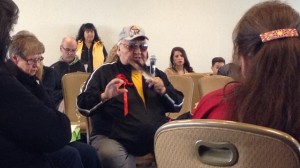Kenneth Jackson
APTN National News
OTTAWA – The eagle feather and a microphone slowly go around the circle stopping at each residential school survivor sharing their story to the public.
Nine survivors – their stories similar, but their own.
Murray Crowe from Kitchenuhmaykoosib in northern Ontario attended schools in Pelican Falls and Poplar Hills.
“The hardest thing about going to the school is the first few days when the light goes out in the dorm,” said Crowe. “That’s when you know you’re not with your mom anymore and that’s when you start crying.”
When he cried Crowe got the strap – so hard it’d cut the skin. When he’d turn his hand in pain they’d strap the other side.
“Every time I was caught talking my language I’d get severe punishment,” said Crowe who first went to a school when he was seven and never spoke of it for 45 years because he was “ashamed.”
About 150,000 Aboriginal children were taken from their homes and put in schools run by religious denominations like Catholic and Anglican – all funded by the Canadian government.
“The hardest thing about going to the school is the first few days when the light goes out in the dorm.” Murray Crowe, Survivor
Up to 6,000 children died at the schools and the those that survived carried the pain with them through generations. The last schools closed in 1996 in Saskatchewan. In 2008, the federal government apologized and began the Truth and Reconciliation Commission that set up to hear each survivor’s stories and offer compensation. To date, nearly $1.9 billion has been paid to survivors.
The commission’s final report is set to be released Tuesday in Ottawa.
As part of the report’s release, hundreds of survivors are in Ottawa to take part in ceremonies and sharing circles like the one Crowe was at Monday morning in the penthouse of the Delta hotel.
Patricia “Patsy” Stephens was taken to the Shubenacadie residential school in Nova Scotia.
The abuse and pain suffered at the school carried on with Stephens through life.
“Like a glass that was dropped and shattered – That’s how my life was,” said Stephens but with healing she has seen her life “slowly all coming together” again.
The atrocities suffered by Aboriginal children was hidden from the Canadian public for generations. It’d be hard to find details of residential schools in school books even today.

“I believe a lot change is going to happen and it’s going to be for the better,” said Stephens. “It’s not hidden anymore. I truly believed it’s going to be in the (curriculum) books. It’s going to be taught.”
Mary Hookimawillillene was forced into residential schools for six years.
She recalled the girls in her dorm would have to put their underwear at the end of the bed at night.
A nun would come by and smell each one. If she smelt pee she’d lift the underwear up and tell everyone how dirty the girl was.
Hookimawillillene recalled one young girl who couldn’t stop crying.
The nuns locked her in the basement. Her cries could be heard in Hookimawillillene’s dorm three floors up.
“I could hear her crying for help,” she said. “I couldn’t sleep just listening to her.
The sharing circles continue through the day and Tuesday.










